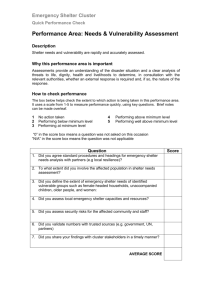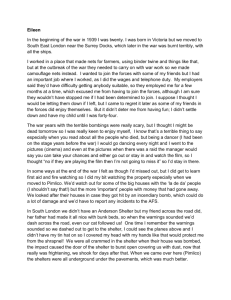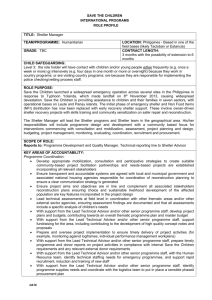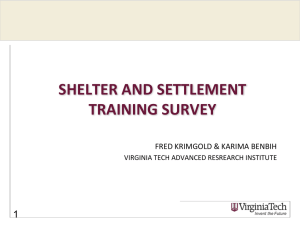Regulatory Barriers WG Summary
advertisement
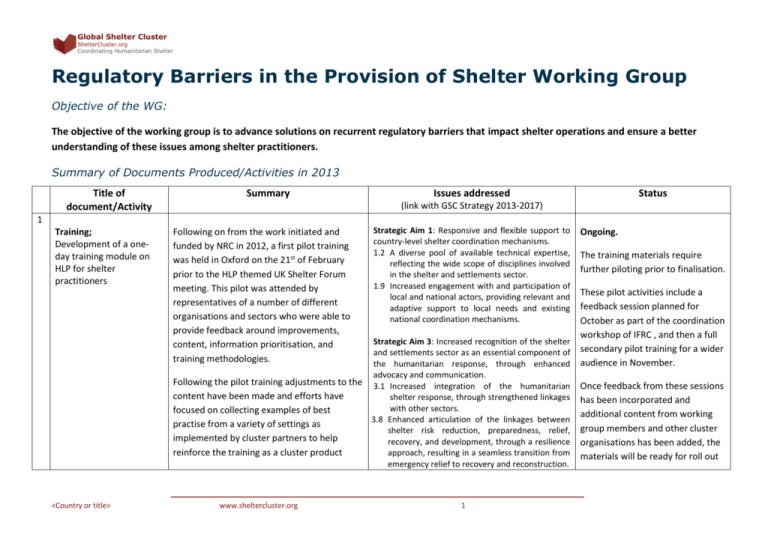
Global Shelter Cluster ShelterCluster.org Coordinating Humanitarian Shelter Regulatory Barriers in the Provision of Shelter Working Group Objective of the WG: The objective of the working group is to advance solutions on recurrent regulatory barriers that impact shelter operations and ensure a better understanding of these issues among shelter practitioners. Summary of Documents Produced/Activities in 2013 Title of document/Activity Summary Issues addressed Status (link with GSC Strategy 2013-2017) 1 Training; Development of a oneday training module on HLP for shelter practitioners Following on from the work initiated and funded by NRC in 2012, a first pilot training was held in Oxford on the 21st of February prior to the HLP themed UK Shelter Forum meeting. This pilot was attended by representatives of a number of different organisations and sectors who were able to provide feedback around improvements, content, information prioritisation, and training methodologies. Strategic Aim 1: Responsive and flexible support to country-level shelter coordination mechanisms. 1.2 A diverse pool of available technical expertise, reflecting the wide scope of disciplines involved in the shelter and settlements sector. 1.9 Increased engagement with and participation of local and national actors, providing relevant and adaptive support to local needs and existing national coordination mechanisms. Ongoing. The training materials require further piloting prior to finalisation. These pilot activities include a feedback session planned for October as part of the coordination workshop of IFRC , and then a full Strategic Aim 3: Increased recognition of the shelter and settlements sector as an essential component of secondary pilot training for a wider the humanitarian response, through enhanced audience in November. advocacy and communication. Following the pilot training adjustments to the 3.1 Increased integration of the humanitarian content have been made and efforts have shelter response, through strengthened linkages with other sectors. focused on collecting examples of best 3.8 Enhanced articulation of the linkages between practise from a variety of settings as shelter risk reduction, preparedness, relief, implemented by cluster partners to help recovery, and development, through a resilience reinforce the training as a cluster product approach, resulting in a seamless transition from emergency relief to recovery and reconstruction. <Country or title> www.sheltercluster.org 1 Once feedback from these sessions has been incorporated and additional content from working group members and other cluster organisations has been added, the materials will be ready for roll out Global Shelter Cluster ShelterCluster.org Coordinating Humanitarian Shelter and use by all Shelter cluster coordinators. As part of this process a field level training is envisaged for 2014. Greater support from the cluster leads is required to prioritise finalisation of these materials as well as commitment to promote usage and roll out. 2 Guidance; Development of an HLP check list for shelter practitioners linked to training and resource guides A checklist has been developed to assist shelter actors in ensuring consider HLP considerations into programme design and assist shelter actors with identifying land rights in contexts where this information is difficult to obtain. This checklist has been designed to be in line with the work of the accountability and coherence working groups on developing assessments, strategy templates, reporting, monitoring and evaluation tools. The checklist and the HLP training have been developed in coordination and simultaneously to ensure coherence. This checklist will result in two separate products, (i) a full and comprehensive <Country or title> www.sheltercluster.org Strategic Aim 1: Responsive and flexible support to country-level shelter coordination mechanisms. 1.4 Provision of technical advice for shelter sector emergency preparedness and contingency planning. Strategic Aim 2: An effective and well-functioning Global Shelter Cluster. 2.4 Consistency in technical standards, specifications, reporting, indicators and policies. 2.8 Active participation in IASC activities and intercluster initiatives. Strategic Aim 3: Increased recognition of the shelter and settlements sector as an essential component of the humanitarian response, through enhanced advocacy and communication. 3.6 Increased integration of the humanitarian shelter response, through strengthened linkages with other sectors. 2 Complete and under review. Documents to be posted to cluster website and disseminated. Global Shelter Cluster ShelterCluster.org Coordinating Humanitarian Shelter checklist that is targeted more at coordinators and, (ii) a simpler booklet version of key issues for shelter practitioners. 3 HLP Resources; Following consultation the HLP AoR of the Protection Cluster kindly agreed to build on 1. Easily accessible initial efforts of the RBWG and prepare a annotated HLP resource guide of the most relevant and resource guide important HLP resources for Shelter 2. Access to and capacity practitioners. This guidance document has for HLP AOR helpdesk been finalised and circulated to partners – further distribution and promotion is now required to ensure broad dissemination. This guide along with continued reinforcement of the linkages between the Shelter cluster RBWG and the HLP AoR will hopefully ensure Shelter practitioners in the field are aware of the support available on HLP related matters from the HLP AoR helpdesk. Strategic Aim 1: Responsive and flexible support to country-level shelter coordination mechanisms. 1.1 A diverse pool of available technical expertise, reflecting the wide scope of disciplines involved in the shelter and settlements sector. 1.5 Provision of technical advice for shelter sector emergency preparedness and contingency planning. 1.7 Available capacity to provide learning support for ongoing shelter responses, by reviewing and defining success, and capturing and sharing innovation and good practice in the field through interagency impact evaluations, reviews, and other learning support options. Strategic Aim 2: An effective and well-functioning Global Shelter Cluster. 2.5 Consistency in technical standards, specifications, reporting, indicators and policies. 2.9 Active participation in IASC activities and intercluster initiatives. 2.10 Enhanced partnerships among shelter actors allow for pooling resources and ensuring complementarity of efforts. 2.11 A clear and predictable division of responsibilities with other clusters. Strategic Aim 3: Increased recognition of the shelter and settlements sector as an essential component of the humanitarian response, through enhanced advocacy and communication. 3.7 Increased integration of the humanitarian <Country or title> www.sheltercluster.org 3 Complete. Document needs to be posted to cluster website alongside links to AoR helpdesk/website. Global Shelter Cluster ShelterCluster.org Coordinating Humanitarian Shelter shelter response, through strengthened linkages with other sectors. 4 Land Mapping; Members of the working group were consulted and provided feedback on the 1. Half a day work concept note on community land mapping, shop/consultation on drafted by IFRC. community land mapping Following this a number of members shared experience in the shelter relevant mapping tools, papers and reflection sector (Haiti, on the subject to assist IFRC in establishing the Afghanistan…) to capture minimum elements of a community land and highlight best practice mapping programme to be used in a post and lessons of experience. disaster scenario. In addition to this IFRC has carried out a 2. Concept note on mapping exercise not just focusing on the developing land mapping humanitarian sector but also looking at tools or guidance peer development projects, especially slum reviewed upgrading and the protection of community 3. Depending on output of property rights. 2, participation in the development of tools under IFRC's lead. <Country or title> www.sheltercluster.org Strategic Aim 1: Responsive and flexible support to country-level shelter coordination mechanisms. 1.7 Available capacity to provide learning support for ongoing shelter responses, by reviewing and defining success, and capturing and sharing innovation and good practice in the field through interagency impact evaluations, reviews, and other learning support options. Ongoing The result of the mapping exercise has identified a need for consultation and research on how to include those who are reluctant to be identified through assessments or mapping processes Strategic Aim 3: Increased recognition of the shelter especially when local/municipal and settlements sector as an essential component of authorities are involved. the humanitarian response, through enhanced It is proposed that this will be advocacy and communication. carried out by means of a 3.6 Increased integration of the humanitarian consultation with members and shelter response, through strengthened linkages research/lessons learnt from with other sectors. previous urban crisis mapping 3.8 Enhanced articulation of the linkages between shelter risk reduction, preparedness, relief, programmes. recovery, and development, through a resilience Subject to the research above, approach, resulting in a seamless transition minimum elements for mapping from emergency relief to recovery and with a guidance paper will be reconstruction. drafted in consultation with the working group members. 4 Global Shelter Cluster ShelterCluster.org Coordinating Humanitarian Shelter 5 Security of Tenure Although not directly a product of the Working Group, a joint collaboration between NRC and IFRC related to the issues around security of tenure has also involved a number of the working group members and compliments the ongoing efforts of the WG and its objectives. NRC and IFRC (with funding from DFID) jointly organised a two day meeting in June, the focus of which was on the impact that security of tenure can have on the delivery of humanitarian shelter assistance. In preparation for this meeting, a background paper was jointly prepared by NRC and IFRC. Strategic Aim 1: Responsive and flexible support to country-level shelter coordination mechanisms. The first day saw members of the working group and others meeting with the UN Special Rapporteur on adequate housing to discuss how security of tenure impacts shelter programming, this in turn also informed her upcoming guidelines on security of tenure for the urban poor. The background paper was discussed and suggestions made for improvement and refinement. Global Shelter Cluster. The second day (a Roundtable meeting) saw a number of donors and shelter agencies working towards a better understanding of security of tenure, the outcome of which was an agreement that practical guidance on the subject was required. NRC and IFRC will continue to work on this area. Ongoing consultation will be sought from members of the working group given their expertise, experience and Strategic Aim 2: An effective and well-functioning expressed interest on the subject. 1.9 Increased engagement with and participation of local and national actors, providing relevant and adaptive support to local needs and existing national coordination mechanisms. 2.4 Consistency in technical standards, specifications, reporting, indicators and policies. 2.9 Enhanced partnerships among shelter actors allow for pooling resources and ensuring complementarity of efforts. Strategic Aim 3: Increased recognition of the shelter and settlements sector as an essential component of the humanitarian response, through enhanced advocacy and communication. 3.1 A raised profile and understanding of the humanitarian shelter sector, resulting in a reduced gap in funding coverage of stated shelter needs. 3.3 Coherent, coordinated and targeted public communication and advocacy on humanitarian shelter issues, with governments and other Members of the working group were asked by humanitarian stakeholders. the Special Rapporteur to provide feedback on her guidelines and a coordinated response was provided. <Country or title> www.sheltercluster.org Ongoing 5 The proposed work will see the development of the ‘secure enough’ approach so as to ensure more equitable shelter assistance in both conflict and disaster programmes. Global Shelter Cluster ShelterCluster.org Coordinating Humanitarian Shelter Proposal for 2014 The Regulatory Barriers to Shelter Working Group plans to continue into 2014, in order to complete the above and to facilitate the dissemination of the documents and tools to country-level Clusters. Additionally awareness within the sector and donor communities around the importance of HLP to the efficient delivery of humanitarian shelter is growing and as such opportunities to expand knowledge and learning are also increasing. The organisations represented within the RBWG as such are in a unique position to facilitate the shelters clusters efforts to develop expertise and provide support to field level shelter activities. <Country or title> www.sheltercluster.org 6



